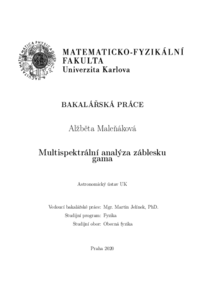Multispektrální analýza záblesku gama
Multi-spectral analysis of a gamma-ray burst
bakalářská práce (OBHÁJENO)

Zobrazit/
Trvalý odkaz
http://hdl.handle.net/20.500.11956/120463Identifikátory
SIS: 221112
Kolekce
- Kvalifikační práce [11196]
Autor
Vedoucí práce
Oponent práce
Münz, Filip
Fakulta / součást
Matematicko-fyzikální fakulta
Obor
Obecná fyzika
Katedra / ústav / klinika
Astronomický ústav UK
Datum obhajoby
3. 9. 2020
Nakladatel
Univerzita Karlova, Matematicko-fyzikální fakultaJazyk
Čeština
Známka
Výborně
Klíčová slova (česky)
gama záblesky, optický dosvit, FRAMKlíčová slova (anglicky)
gamma ray bursts, optical afterglow, FRAMGama záblesky jsou fascinující vysoce energetické jevy, spojené se supernovami i čer- nými děrami, které byly objeveny náhodou v druhé polovině 20. století. Tato práce má za cíl provést multispektrální analýzu záblesku GRB 190919B po seznámení se základními poznatky o tomto úkazu. Snímky optického dosvitu z robotických dalekohledů FRAM a BOOTES umožnily sestavení fotometrické světelné křivky daného záblesku. Spolu s volně dostupnými daty z dalších spektrálních oborů bylo možné vytvořit i širokopásmové spektrum. Oba získané grafy jsme posléze fitovali několika funkcemi s rozdílnou volbou omezujících parametrů. Analýzou získaných hodnot jsme obdrželi několik variant scé- náře průběhu pozorovaného záblesku. Určením počátečních Lorentzových faktorů jsme potvrdili, že se všechny tyto možnosti nacházejí v mezích hodnot obvyklých pro model relativistické ohnivé koule. 1
Gamma-ray bursts are fascinating high energy phenomena, related with supernovas and black holes, which were discovered by accident in the second half of the 20. century. The goal of this thesis is to perform a multi-spectral analysis of the GRB 190919B after becoming familiar with the elementary knowledge about this phenomena. The images of an optical afterglow from robotic telescopes FRAM and BOOTES enabled us to construct the photometric light curve of the given burst. Together with the publicly available data from other spectral fields, the spectral energy distribution could be created. Afterwards, we fitted both obtained graphs with several functions with different choices of constraining parameters. Through analysis of the acquired values, we obtained several variants of the scenario of the observed event. By determining the value of initial Lorentz factors, we confirmed that all the options lie within the boundaries of typical values for the model of relativistic fireball. 1
